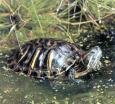|
Care of your
Red Eared Slider

Hatchlings- The hatchlings
of Red Eared Sliders and similar aquatic turtles are
generally hardy and easy to care
for. They do require a habitat that has both a land area and a significant water area. It is important that the turtle be able to get fully out of the water whenever it feels like it. The water portion should have water to a depth where the turtle can stick its head out of the water when it is "standing up" in the water area. A good food to start with is a prepared commercial turtle food (Tetra Reptomin) that has vitamins and minerals already added.
Hatchlings may be fed once or twice a day. Try to avoid adding more food than the turtle will eat, as this will just foul the water faster. A federal phoney-baloney law prohibits the sale of turtles under four inches in shell length, but they are sold everywhere as "food" items, research, or educational items.
Adults- The adults are
maintained in much the same way.
Try to expand the diet as much as you can, adding dark leaf lettuce and other greens, feeder fish, cooked strips of chicken, earthworms, etc. Using larger food items, feedings
can be scaled back to every other day throughout the warmer
months of the year, less often in the cooler months. The larger the turtle, the faster they will foul the water. Do yourself a favor and purchase a large canister filter.
 General-
The Red eared Slider comes from the
southeastern regions of United
States, ranging from Florida to
southern Maryland and west to the
Mississippi and Texas. They are large, active turtles that spend
the daytime hours basking in the sun and foraging for food. A 10-gallon tank
will comfortably house a baby to
turtle, but it will likely outgrow this space within a year. At least a
30-gallon tank, or caging with
similar space to it is more
appropriate for a juvenile and an adult will require something more like a 55 gallon tank. Proper lighting is essential to the long term health of the turtle. A heat bulb and a good UV source are extremely important pieces of equipment to keep your turtle vibrant. Avoid the "death zone" of temperatures in the 60's for prolonged periods of time. These temperatures are too cold to digest food and too warm to hibernate, so the turtle is caught uncomfortably in between. Death will result if the turle is not allowed to shut down its metabolic systems, or estavate. Proper
heating is essential to digestion
and the turtle should have access
to an area that is in the range of
80 to 90 degrees. General-
The Red eared Slider comes from the
southeastern regions of United
States, ranging from Florida to
southern Maryland and west to the
Mississippi and Texas. They are large, active turtles that spend
the daytime hours basking in the sun and foraging for food. A 10-gallon tank
will comfortably house a baby to
turtle, but it will likely outgrow this space within a year. At least a
30-gallon tank, or caging with
similar space to it is more
appropriate for a juvenile and an adult will require something more like a 55 gallon tank. Proper lighting is essential to the long term health of the turtle. A heat bulb and a good UV source are extremely important pieces of equipment to keep your turtle vibrant. Avoid the "death zone" of temperatures in the 60's for prolonged periods of time. These temperatures are too cold to digest food and too warm to hibernate, so the turtle is caught uncomfortably in between. Death will result if the turle is not allowed to shut down its metabolic systems, or estavate. Proper
heating is essential to digestion
and the turtle should have access
to an area that is in the range of
80 to 90 degrees.
Other Helpful Info:
Þ
Always buy a healthy captive
bred animal and learn as much as
you can from the source that you
are buying it from, such as age,
sex, what is it eating, etc.
Þ
Find a local veterinarian who is
knowledgeable about reptiles before
any problems arise!
Þ
Buy a good book about Red Eared Sliders or at least a book with a
decent section about these
animals and keep it on hand for
reference. This care sheet
contains only initial
information to get you started
and is by no means complete.
Þ
Enjoy your Slider! These are
fun and interesting pets.
|